 USA (1888)
USA (1888)USS Baltimore, Philadelphia
WW1 and prewar USN Cruisers
Atlanta class | USS Chicago | USS Newark | USS Charleston | USS Baltimore | USS Olympia | USS Philadelphia | USS San Francisco | Cincinatti class | Montgomery class | Columbia class | New Orleans class | Denver class | Chester class | Omaha classUSS New York | USS Brooklyn | Pennsylvania class | Saint Louis class | Tennessee class
Although you are probably more familiar to the WW2 Baltimore class heavy cruisers, there was already a class of this name in the 1880s. These were excellent ships built in Cramp on an English design (Eltswick), which served during the Spanish-American War of 1898, but placed in reserve in 1904. The USS Philadelphia was a floating barracks at Puget Sound and the USS Baltimore at Charleston from 1911 up to 1917. The USS Baltimore was then converted to a minelayer and took part in the wartime naval operations, was removed from the lists in 1922 and was still registered as a barrack-ship in 1942, an amazing career of 52 years…
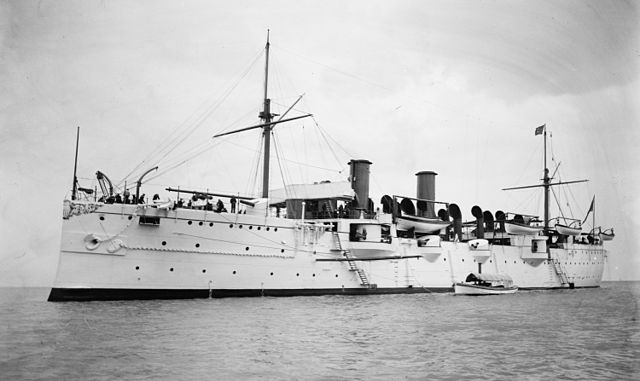
USS Philadelphia, date unknown. The hull was painted white, superstructures beige or “canvas”
Conception of the Baltimore class
This ship was the fifth protected cruiser to be built by an American yard. So the still a bit “green” William Cramp & Sons yard where she was ordered obtained plans left from an unsuccesful bid for the Spanish Navy from W. Armstrong, Mitchell, and Company of Newcastle. This was to be an all-around improvement on USS Charleston, somewhat larger with more guns, thicker armor, and better machinery, and reduced rigging. She also had to be equipped with modern triple expansion engine designed by Humphrys, Tennant & Co.
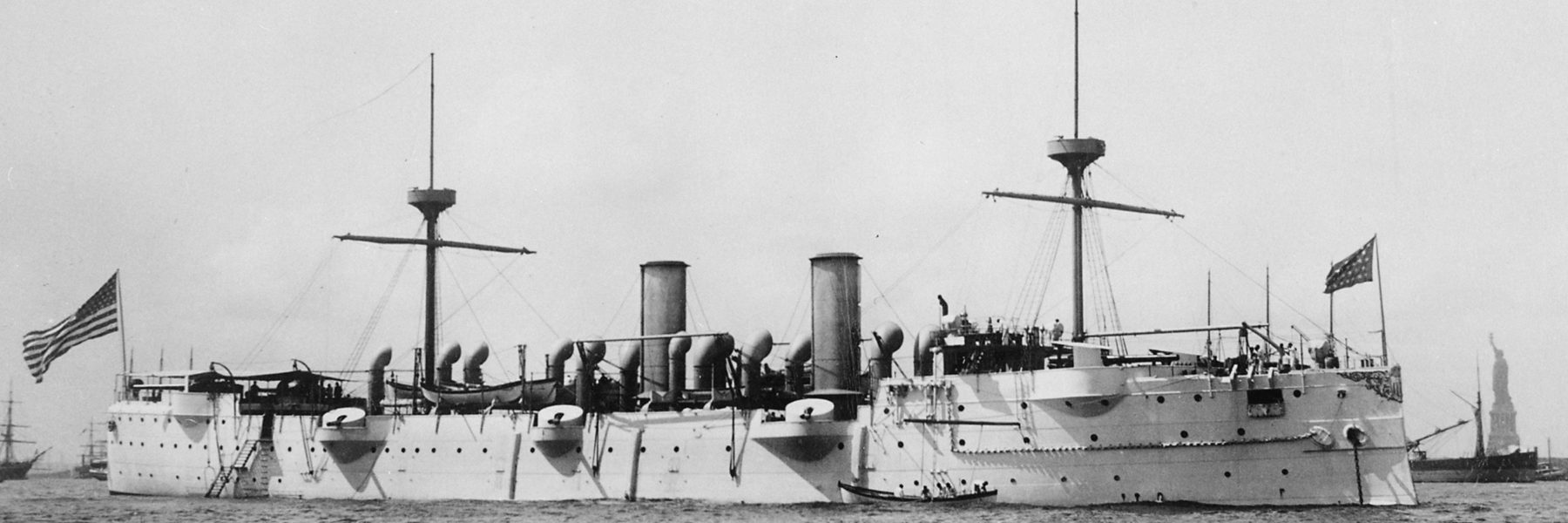
USS baltimore in New York – Statue of Liberty can be seen to the right in the foreground.
About this Eltswick design
The most striking features about the design (which also recalls the Chilean cruiser Esmeralda) was her roomy and tall hull, reduced superstructures and masts. She looked stubby in some way.
All her armament was on sponsons, the four 8-inch (203 mm)/35 caliber Mark 4 guns on either side of the bow and stern and complement of six 6-inch (152 mm)/30 caliber Mark 3 guns. Initially, there was also a provision for Four 14-inch (356 mm) torpedo tubes , which were never mounted. The light artilley comprised quick-firing Hotchkiss guns in the masts tops and superstructure, including two .45 caliber (11.4 mm) Gatling guns for close support rather than dealing with early torpedo boats. The armament was alter modified. The USS Baltimore had a sister ship, the USS Philadelphia.
Her cost, as registered by the navy Dpt. was $1,546,172.13. She was laid down at Cramp on 5 May 1887, launched 6 October 1888 (baptised by Mrs. Theodore D. Wilson, wife of Chief Constructor Wilson), and commissioned on 7 January 1890. She was officially registered as C3.
Important note: The USS Baltimore was among the first US Navy ships fitted with the new triple expansion engines. No sails were fitted and the rigging was minimal, only there to carry the tops and their small guns. The American cruiser carried some 400 tons of coal, giving a range of 3,838 nautic miles or 7,108 km at 10 knots (19 km/h; 12 mph), up to 850 tons in times of war, for 8,155 nmi.
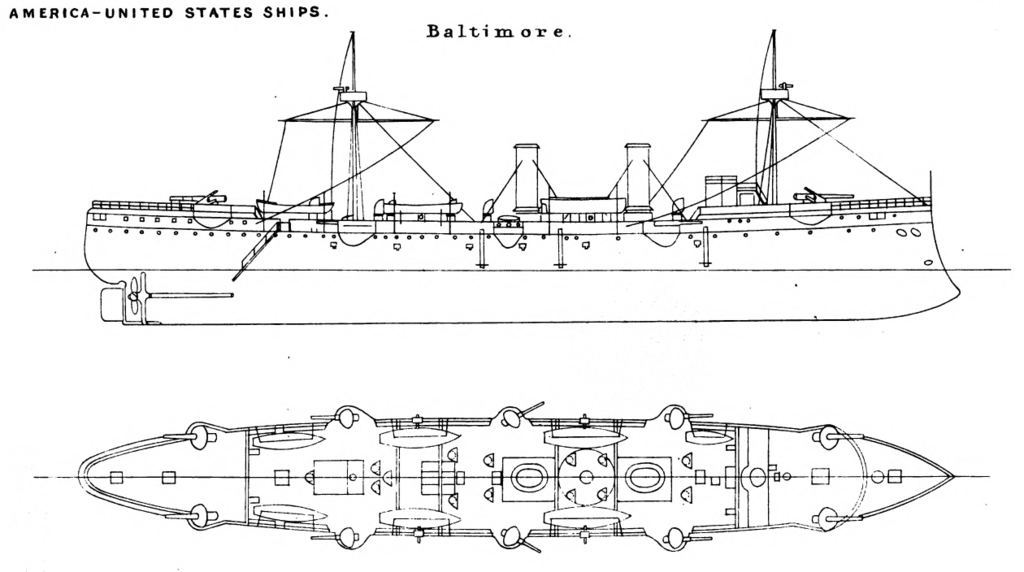
USS Baltimore Career
As soon as she was commissioned in January 1890, the white cruiser became flagship of the North Atlantic Squadron on 24 May. She has the honour of conveying from New York to Stockholm the remains of John Ericsson, the inventor of the Monitor, during the summer. She then cruiserd from the Mediterranean to South America, stopping at Valpairso, Chile. Some of ther crew were stabbed to death at that time, the cruiser heading newspapers as the “Baltimore Crisis”. She transited from Mare Island Navy Yard to the east coast ion 1892. She departed Hampton Roads and sailed in the Mediterranean, crossed the Suez canal in 1893 to reach the Asiatic squadron. She returned home in 1896. Briefly decommissioned she sailed to the Hawaiian islands and then joined Commodore George Dewey’s squadron at Hong Kong in 1898.
When the war broke out with Spain, she joined the attack in the Philippines, on 1 May she entered Manila Bay and helped destroy the Spanish fleet, as second in line behind USS Olympia. She then spent the remainder in the Philippine–American War protecting convoys and landing troops notably at Lloilo City, until returning home in 1900. Until 1903 she was decommissioned and in drydock at New York Navy Yard for refit, with 12x 6-inch (152 mm)/40 caliber Mark 7 guns, being fitted and the 8-inch guns removed and replaced by six 3-inch (76 mm)/50 caliber guns. The boilers were replaced with eight new Babcock & Wilcox models. She was back in the Carribean squadron, and in 1904-1905 was attached to the European Squadron cruising in the Mediterranean, and later until 1906 cruised in Asiatic, Philippine, and Australian waters. She was back home in 1907, and decommissioned. She was reactivated but only for the reserve as a receiving ship in 1911-1912, and taken in hands the next year to be converted as a minelayer at Charleston Navy Yard. She was given four new 6 in/40 guns and deck rails for a capacity of 180 mines. Shortly before the US entering the war, she was again modified, her guns being replaced with 5x 5-inch (127 mm)/51 caliber models plus 2x 3 inch (76 mm)/50 cal. AA models.
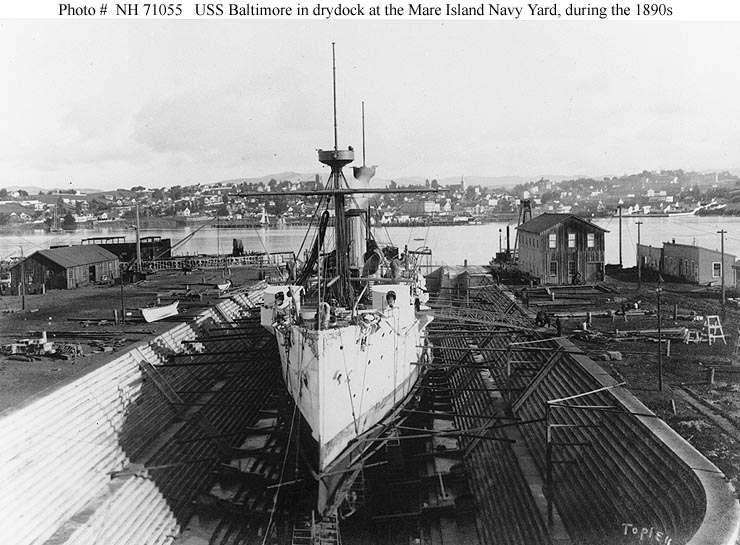
USS Baltimore at Mare Island naval yard in 1892
During WW1 she performed as a training ship before being used in her intended new role, laying in succession 1200+ mines in seven summer excursions until Setpember 1917 between the Orkney Islands and Norway. In September 1919 she joined the Pacific Fleet, as CM-1 (cruiser minelayer), and stayed on the west coast, then joined Pearl Harbour before final decommission in 1922. However the story did not stop there. She indeed served as a receiving ship until December 1941, seeing first hand the Japanese attack. She survived, and was sold for scrap on 16 February 1942. However it seems she was scutted at sea in 1944 as her hull was rediscovered in September 2017 by the Okeanos Explorer.
USS Philadelphia Career

The sister-ship C-4 (later IX-24) was the sixth American protected cruiser, laid down 22 March 1888 and launched on 7 September 1889, to be commissioned after trials on 28 July 1890. She was decommissioned as a cruiser 22 September 1902 and spent the rest of here career partially and then completely disarmed as a receiving ship, and prison ship. When fitting out she became the flagship of Rear Admiral Bancroft Gherardi, commanding the North Atlantic Squadron. In 1891 she cruised the West Indies and was back to Uruguay. She was at Hampton Roads on 8 April for a large naval review before the president until 1893 and then joined the Pacific Squadron via Rio de Janeiro, Brazil, and Callao, Peru. She was stationed at the Pacific Station from 1893 to 1902 as flagship of the Commander-in-Chief. She was present and represented the US Navy at the ceremonies transferring the Hawaiian Islands to the United States in 1898. In 1899 she was stationed at the Samoan Islands. She arrived San Francisco 17 July 1902 her hull needed much repairs and refit, so she was decommissioned instead at Puget Sound 22 September 1902. She was eventually a receiving ship again on 10 January 1916, and was redesignated hull number IX-24 on 17 July 1920, and stayed as such until struck from the Navy List on 24 November 1926 and broken up the next year.
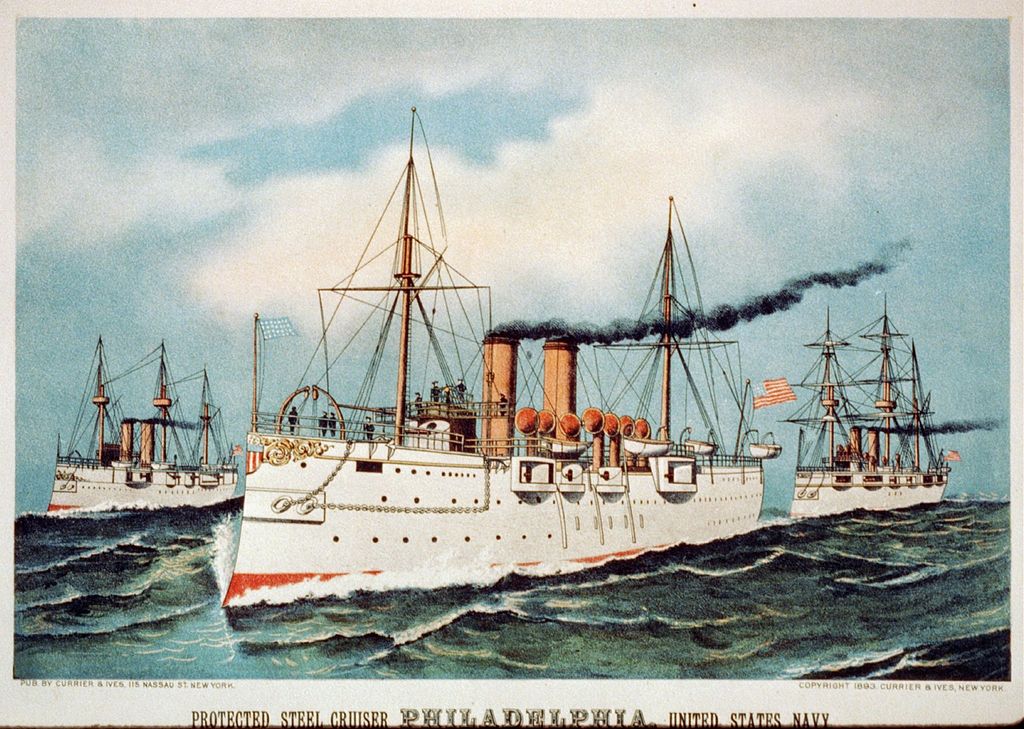
Commemorative stamp of the great naval review of 1893
Specifications 1890
Diplacement: 4413 tonnes Normal, 5436 tonnes Fully Loaded
imensions 102,11 x 14,78 x 5,94 m (336 x 40.6 x 20.6 ft)
Propulsion: 4 shafts HTE, 4 coal-fired boilers 10,750 ihp for 19 knots. Coal ? tons
Crew: 386
Armor: Gun shields: 4.5 in (110 mm), Main deck: 4 in (100 mm), Conning Tower: 3 in (76 mm)
Armament: 4 x 8in (203 mm), 6 x 6in (152 mm), 4 x 3in (75 mm), 2 x 3-pdr (47mm) and 2 x 1-pdr (37 mm), no TT.
Sources
https://en.wikipedia.org/wiki/USS_Baltimore_(C-3)
https://en.wikipedia.org/wiki/USS_Philadelphia_(C-4)


 Latest Facebook Entry -
Latest Facebook Entry -  X(Tweeter) Naval Encyclopedia's deck archive
X(Tweeter) Naval Encyclopedia's deck archive Instagram (@navalencyc)
Instagram (@navalencyc)





 French Navy
French Navy Royal Navy
Royal Navy Russian Navy
Russian Navy Armada Espanola
Armada Espanola Austrian Navy
Austrian Navy K.u.K. Kriegsmarine
K.u.K. Kriegsmarine Dansk Marine
Dansk Marine Nautiko Hellenon
Nautiko Hellenon Koninklije Marine 1870
Koninklije Marine 1870 Marinha do Brasil
Marinha do Brasil Osmanlı Donanması
Osmanlı Donanması Marina Do Peru
Marina Do Peru Marinha do Portugal
Marinha do Portugal Regia Marina 1870
Regia Marina 1870 Nihhon Kaigun 1870
Nihhon Kaigun 1870 Preußische Marine 1870
Preußische Marine 1870 Russkiy Flot 1870
Russkiy Flot 1870 Svenska marinen
Svenska marinen Søværnet
Søværnet Union Navy
Union Navy Confederate Navy
Confederate Navy Armada de Argentina
Armada de Argentina Imperial Chinese Navy
Imperial Chinese Navy Marinha do Portugal
Marinha do Portugal Mexico
Mexico Kaiserliche Marine
Kaiserliche Marine 1898 US Navy
1898 US Navy Sovietskiy Flot
Sovietskiy Flot Royal Canadian Navy
Royal Canadian Navy Royal Australian Navy
Royal Australian Navy RNZN Fleet
RNZN Fleet Chinese Navy 1937
Chinese Navy 1937 Kriegsmarine
Kriegsmarine Chilean Navy
Chilean Navy Danish Navy
Danish Navy Finnish Navy
Finnish Navy Hellenic Navy
Hellenic Navy Polish Navy
Polish Navy Romanian Navy
Romanian Navy Turkish Navy
Turkish Navy Royal Yugoslav Navy
Royal Yugoslav Navy Royal Thai Navy
Royal Thai Navy Minor Navies
Minor Navies Albania
Albania Austria
Austria Belgium
Belgium Columbia
Columbia Costa Rica
Costa Rica Cuba
Cuba Czechoslovakia
Czechoslovakia Dominican Republic
Dominican Republic Haiti
Haiti Hungary
Hungary Honduras
Honduras Estonia
Estonia Iceland
Iceland Eire
Eire Equador
Equador Iran
Iran Iraq
Iraq Latvia
Latvia Liberia
Liberia Lithuania
Lithuania Mandchukuo
Mandchukuo Morocco
Morocco Nicaragua
Nicaragua Persia
Persia San Salvador
San Salvador Sarawak
Sarawak Uruguay
Uruguay Venezuela
Venezuela Zanzibar
Zanzibar Warsaw Pact Navies
Warsaw Pact Navies Bulgaria
Bulgaria Hungary
Hungary

 Bundesmarine
Bundesmarine Dutch Navy
Dutch Navy Hellenic Navy
Hellenic Navy Marina Militare
Marina Militare Yugoslav Navy
Yugoslav Navy Chinese Navy
Chinese Navy Indian Navy
Indian Navy Indonesian Navy
Indonesian Navy JMSDF
JMSDF North Korean Navy
North Korean Navy Pakistani Navy
Pakistani Navy Philippines Navy
Philippines Navy ROKN
ROKN Rep. of Singapore Navy
Rep. of Singapore Navy Taiwanese Navy
Taiwanese Navy IDF Navy
IDF Navy Saudi Navy
Saudi Navy Royal New Zealand Navy
Royal New Zealand Navy Egyptian Navy
Egyptian Navy South African Navy
South African Navy






























 Ukrainian Navy
Ukrainian Navy dbodesign
dbodesign